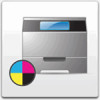Lexmark Color Laser Connectivity guide
Lexmark Color Laser Manual
 |
View all Lexmark Color Laser manuals
Add to My Manuals
Save this manual to your list of manuals |
Lexmark Color Laser manual content summary:
- Lexmark Color Laser | Connectivity guide - Page 1
guide Windows instructions for a locally attached printer Note: When installing a locally attached printer, if the operating system is not supported by the Software and Documentation CD, the Add Printer Wizard must be used. Updates for the printer software may be available on the Lexmark - Lexmark Color Laser | Connectivity guide - Page 2
guide Page 2 of 6 4 Specify the location of the printer software. The path should be similar to D:\Drivers\Print\Win_9xMe\, where D is the letter of your CD-ROM drive. 5 Click OK. Windows instructions for network-attached printers What is network printing? In Windows environments, network printers - Lexmark Color Laser | Connectivity guide - Page 3
Connectivity guide Page 3 of 6 Installing software for shared printing Setting up shared printing requires several steps and should be done in the following order: 1 Install the printer software on the computer attached to the printer. a Insert the Software and Documentation CD. If the install - Lexmark Color Laser | Connectivity guide - Page 4
Repeat step a through step e to enable each network computer to print to the shared printer. Notes: • For more information, see the Lexmark Web site at www.lexmark.com. Look for a Knowledgebase article about 64-bit support. • This method may be the best use of system resources. The computer attached - Lexmark Color Laser | Connectivity guide - Page 5
is properly connected and the printer is turned on. After the printer appears in the Printer list, quit the Print Center or Printer Setup Utility. Mac instructions for network-attached printers Installing software for network printing To print to a network printer, each Macintosh user must install - Lexmark Color Laser | Connectivity guide - Page 6
, see the network setup page under the AppleTalk heading. For information about printing a network setup page, see the User's Guide. f From the list, select the new printer, and then click Add. • Using IP printing a Open the Finder, click Applications, and then click Utilities. b Double-click Print

Connectivity guide
Windows instructions for a locally attached printer
Note:
When installing a locally attached printer, if the operating system is not supported by the
Software and
Documentation
CD, the Add Printer Wizard must be used.
Updates for the printer software may be available on the Lexmark Web site at
www.lexmark.com.
What is local printing?
Local printing is printing to a locally attached printer (a printer that is connected directly to your computer with a USB
or parallel cable). When setting up this type of printer with a USB cable, you should install the printer software
before
connecting the USB cable. For more information, see the setup documentation.
The
Software and Documentation
CD can be used to install the necessary printer software on most Windows operating
systems.
Installing software using the CD
Using the
Software and Documentation
CD, you can install printer software for the following operating systems:
•
Windows Vista
•
Windows Server 2003 and Windows Server 2003 x64
•
Windows XP and Windows XP x64 bit Edition
•
Windows 2000
•
Windows Me
•
Windows NT 4.0
•
Windows 98 Second Edition (USB not supported)
1
Insert the
Software and Documentation
CD.
If the install screen does not appear, click
Start
Run
, and then type
D:\setup.exe
, where D is the letter of
your CD-ROM drive.
2
Select
Install Printer and Software
.
3
Select
Suggested
, and then click
Next
.
4
Select
Local Attach
, and then click
Next
. The printer software is copied to your computer.
5
Connect the USB or parallel cable, and then turn on the printer.
The Plug and Play screen appears, and a printer object is created in the Printers folder.
Installing software using the Add Printer Wizard
You can install printer software for the following operating systems:
•
Windows 98 First Edition (USB not supported)
•
Windows 95 (USB not supported)
1
Insert the
Software and Documentation
CD.
If the CD automatically starts, click
Exit
.
2
Click
Start
Settings
Printers
, and then click
Add Printer
to start the Add Printer Wizard.
3
When prompted, select to install a local printer, and then click
Have Disk
.
Connectivity guide
Page 1 of 6








